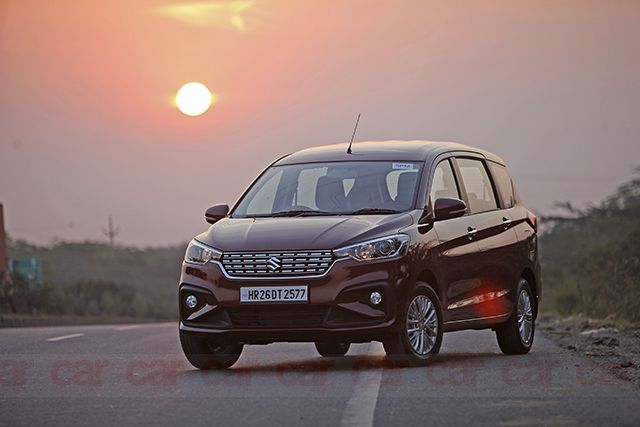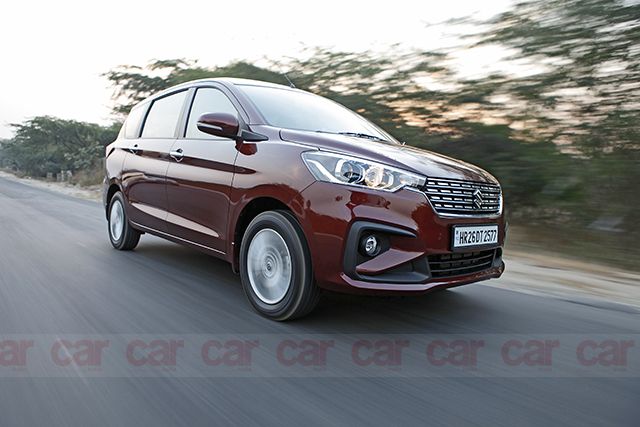
The first generation Ertiga was introduced in India in 2012 and having completed its life cycle, the family car has now been given a a major revamp. This includes a new Heartect platform which underpins the Swift, the Baleno and the Dzire. With abundant use of high tensile steel, the Ertiga is 20 kg lighter than before and safer in case of a mishap. It’s also larger now, while the suspension setup has been improved further, and the 2018 model gets a larger capacity K15 petrol engine equipped with 48-volt electrical systems.
Design
The new Ertiga is a lot better looking than the older model and definitely more premium and upmarket now. The front design is taller and flatter now, and higher variants also get a chromium-plate grille. The headlamp is sharp and come with projector units. A sportier looking front bumper has a stylish fog lamp housing, while the prominent creases on the bonnet complete the aggressive front design. At the back, the tail-lamp are positioned high and overlaps the boot lid, while the chrome strip adds a dash of bling. The overall rear design language, however, seems inspired by some models of other car makers.
[metaslider id=20008]
Interior
The Ertiga has grown in size – is wider, taller and, more importantly, longer as well. This gives it a big-car like appeal and also carves out more knee room on all three rows of seating. The new dashboard design is flatter and more upright now, and gets an interesting set of slats to match the a-c vents. Like many luxury cars, there isn’t a large centre console, which makes the cabin look pretty premium. Higher variants get a floating-type 7-inch touchscreen infotainment system with Android Auto, Apple CarPlay, navigation system and a rear camera. In terms of safety features, the Ertiga gets dual airbags, ABS with EBD, and the newly implemented 80 km/h and 120 km/h alerts.
Other features include a couple of USB ports in front, and charging outlets on the second and third-row seats. The good bit here is the roof mounted a-c vents for the rear passengers, while the top two variants also get automatic climate control. All three rows get cup and bottle holders, but the ones on the front come with cooling vents.

Seats and Storage
There’s clearly more all-around shoulder-room. The front seats are supportive and yet soft enough and remain comfortable even during long hours of driving. The second row gets a convenient single touch slide function and is 60:40 split to improve third-row knee-room and storage space. This bench type seat isn’t as supportive but offers decent comfort. The last row is not just 50:50 split but also gets reclining backrest. It is flat and very low, making them least accommodating here.
With the third row in place, you get 209-litre of storage that can accommodate a couple of suitcases. Toppling the third row opens up a total of 550-litre luggage area, which can be increased further to 803-litre if you fold the second row of seats. There’s plenty of utility space in the car, like a split luggage board which can be used for extra storage.
Engine and Performance
We started our drive with the new K15, 1.5-litre petrol which was recently introduced with the new Ciaz. The four-cylinder engine makes 105 PS at 6,000 rpm and 138 Nm of torque which comes at 4,400 rpm. It gets a mild-hybrid system with dual battery setup, where one acts as a usual power supply while the second battery, located under co-driver seat, uses brake energy regeneration to assist the engine. The petrol comes with either a five-speed manual, which we drove or the four-speed automatic which we hope to drive soon. The manual shifts have precise, short throws which, with a light clutch, make living with it nice and easy.
[metaslider id=19801]
Ride and Handling
The Ertiga suspension has been improved and tuned for stability and comfort, and now the ride feels plusher than before. Thanks to the good rebound damping, it remains impressively composed over bad roads. Even while driving fast over long stretches of undulations, the occupants hardly feel much of the harshness as the seven-seater soaks in most of it.
In fact, it drives more like a tall hatchback than a long MPV. There’s barely any trace of wallowing or pitching and, surprisingly, it doesn’t have the usual body-roll that’s common on big seven-seaters while darting through fast bends. The composed, car-like handling not just makes the Maruti easy to manage but also result in fatigue-free long distance driving. The dependable Bridgestone tyres also have a role to play here, as they maintain a solid grip and never screeched in protest. The only scope for improvement here would be a bit more steering feedback that would make it a more engaging car to drive.

Price
The biggest attraction of the Ertiga is its affordable price. The Maruti undercuts competition like the much larger Toyota Innova Crysta and even the recently introduced Mahindra Marazzo by quite a margin. If you look closely, the base petrol manual LXi variant costs Rs 7.44 lakh (ex-showroom, Delhi) which falls in the price bracket of an average hatchback. The top-spec petrol ZXi+ we drove is priced at Rs 9.50 lakh and the diesel ZDi+ has a sticker of Rs 10.90 lakh (both ex-showroom, Delhi).





















Leave a Reply